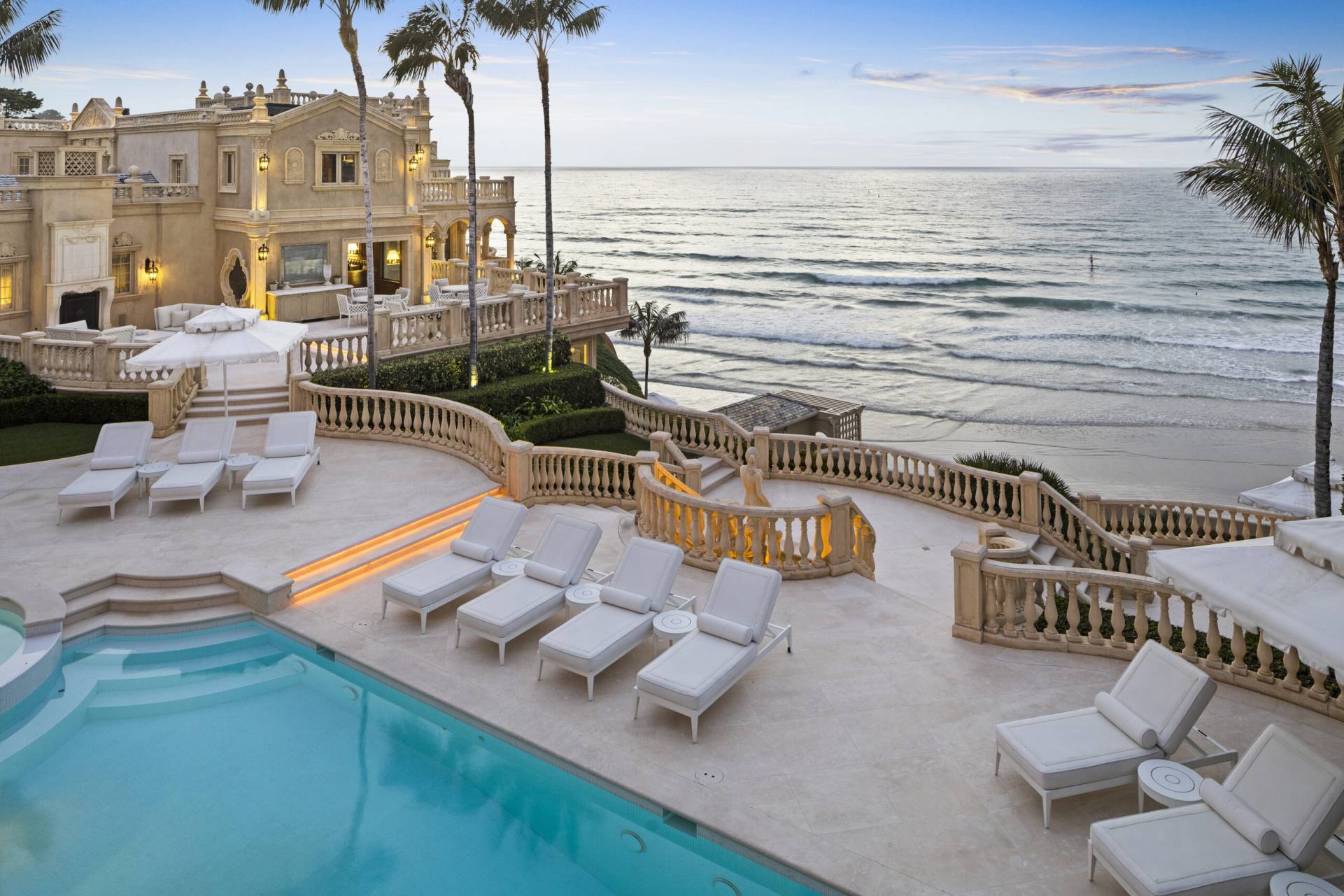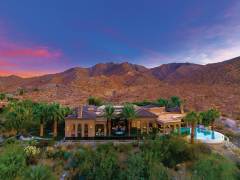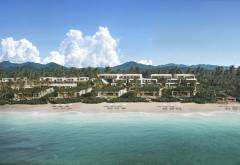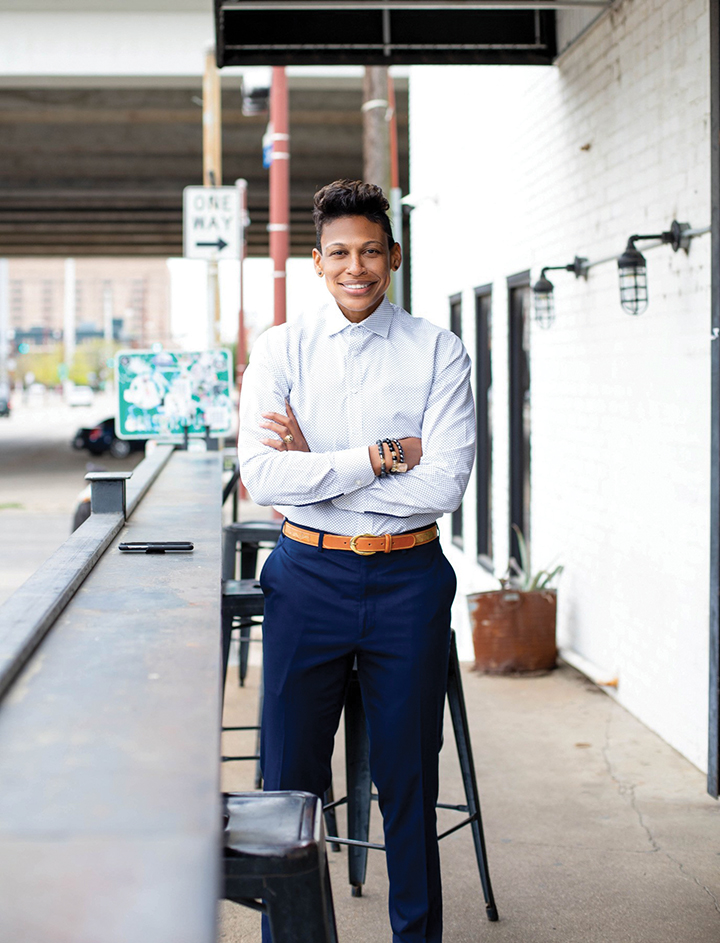
Khaliah O. Guillory, Owner of Nap Bar
A new set of businesses aims to help a sleep-deprived society relax and rejuvenate.
Nap bars. Upon hearing about this concept, various images come to mind, from a series of bedrooms with designated time slots for napping, to a pillowy oasis set in the clouds. While some ideas are more fantastical than others, the meaning behind many nap bar businesses and their missions is far more down to earth.
Whether naps are offered as a complimentary service or finely curated in a luxury setting, the importance of sleep has been reinvigorated by companies like these who know that the benefits of napping are nothing to sneeze (or snore) at in today’s world.
In recent years, with the rise of globalization and businesses running 24/7, productivity can and has for some time become a priority. Maria Jose Hernandez of recharj, a meditation studio headquartered in Washington, D.C., says the needs of the human body should take precedence, however.
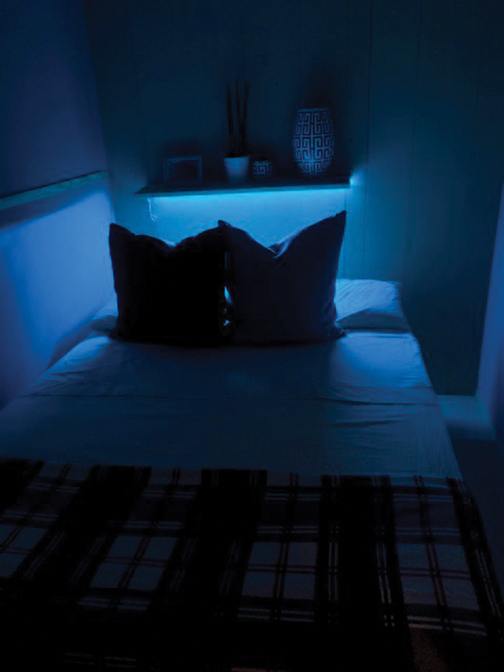
An avid lover of naps since childhood, Guillory developed her company as a way to keep herself from “taking naps in [her] car.”
Photos courtesy Nap Bar.
“Science has proven that sleep is how you are able to learn, retain memory — all these functions that we need to be productive.”
Many nap bars and sleep-oriented businesses have been developed by busy business professionals and entrepreneurs who found themselves suffering from sleep deprivation or sleep-related issues. For example, Khaliah O. Guillory was working at a Fortune 500 company and struggled with getting restful sleep when she was inspired to open Nap Bar in Houston. An avid lover of naps since childhood, she developed her company as a way to keep herself from “taking naps in [her] car,” and engage other young professionals to rest, relax and feel rejuvenated through a curated, white-glove napping experience.
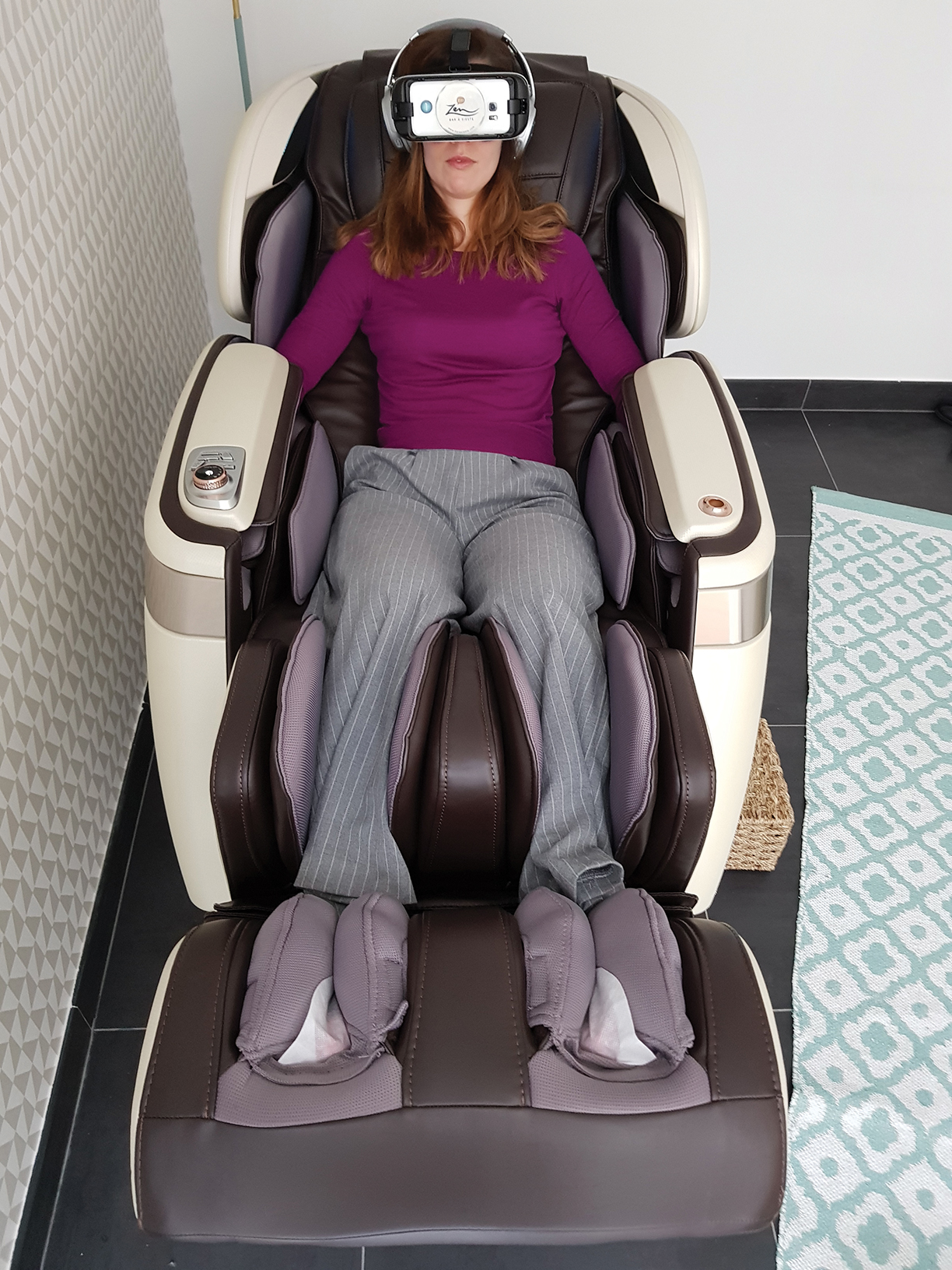
Top: Zen – Bar à Sieste Weightless Chair and VR.
Photos courtesy Zen – Bar à Sieste
Christophe Chanhsavang and his wife, Virginie, have had similar trials and tribulations. From Virginie’s corporate work hours to Christophe’s long hours of study, he realized from his experience working in the UK, China and Greece how much the concept of wellness was nonexistent in the French society. To avoid taking more naps in the office bathroom, Chanhsavang says they founded Zen – Bar à Sieste in 2011 in Paris and have since approached wellness from a holistic perspective by promoting sleep, nutrition, physical activity and mental health.
Professionals in the wellness industry have noted and continue to highlight the importance of sleep, which in turn has led to research and results into the benefits of napping. Guillory offers facts that have helped fuel the educational aspect of Nap Bar, including a NASA statistic that suggests shorter nap durations are better for reducing the impact of sleep inertia, a physiological state of impairment that affects cognitive and sensory-motor performance.*
Mauricio Villamizar, CEO of Pop & Rest in London, takes these findings a step further, noting how a lack of sleep can ultimately lead to disruptions in workflow. “Sleep deprivation is linked to lower productivity at work and it’s one of the main drivers of absenteeism … in the workplace. If we translate this into working days, we are looking at around 200,000 working days being lost each year in the UK only. In terms of economic consequences, it’s around £40 billion, almost 2 percent of the UK’s GDP,” Villamizar says.
Wellness overall has seen a resurgence in strength from businesses like these, as health has come to be the utmost priority of nations around the world. And just like there are many types of methods of getting and staying well, there are a variety of ways to nap.
Pop & Rest is a London-based wellness startup that connects locals and travelers with sleep and meditation pods, offering clients safe and secure spaces to unwind, rest, and work peacefully. According to Villamizar, customers can visit one of the company’s various locations throughout London and become immersed in a calm environment where the pods are situated.
“Once you are inside, your pod will be like a box that features a single bed, small table, along with accessories to change lights, music and the aroma,” he says, noting that everything is built to ensure the best relaxation experience. The pods are movable and soundproofed, and only require a power supply and WiFi connection to function, an enticing offer for companies looking to purchase these pods for their own offices.
The aforementioned Nap Bar curates a luxury napping experience for customers, which Guillory says is ensured by engaging all five senses. For sight, all of the custom suites are outfitted with mood lighting that is adjustable; for taste, a duo of raw juice shots are offered with rich nutrients and ingredients that aid in relaxing the body pre-nap, and waking it up post-nap; for hearing, exclusive brain waves are curated for each client and played inside suites that increases the release of melatonin in the body by 97 percent; and for smell, an aromatherapy pillow mist infused with lavender is available.
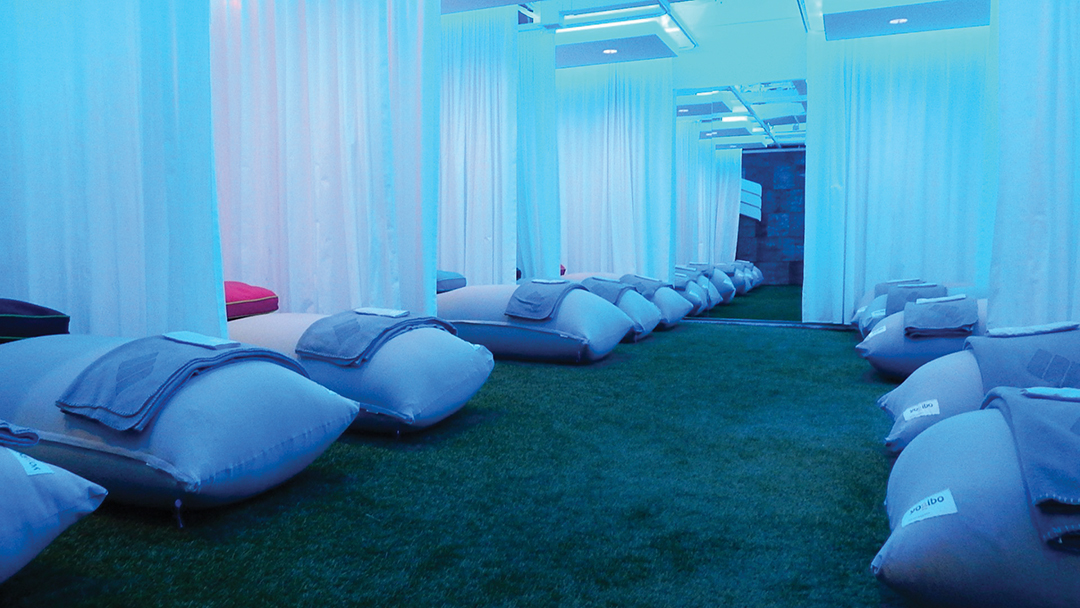
recharj – D.C. meditation room and class.
Photos courtesy recharj
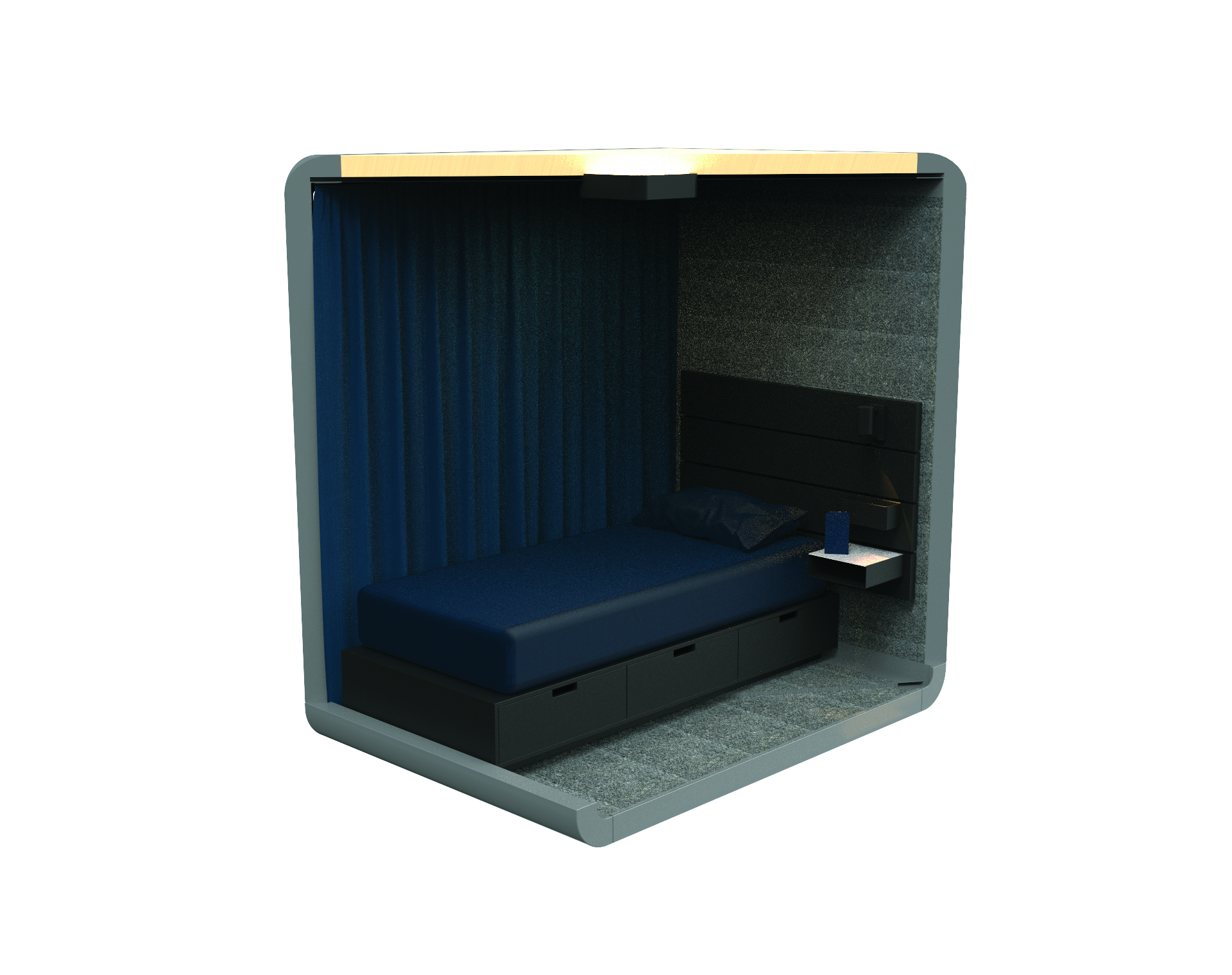
Pop & Rest sleep pod for napping.
Photo courtesy Pop & Rest.
The final sense, of touch, goes a step further, as all suites include an organic, locally sourced mattress, linens and sheets, and each room is painted with toxin-free paint. All of these inclusions are accompanied by a full-service concierge who will guide customers through the experience and help them on their wellness journey
According to Chanhsavang of Zen – Bar à Sieste, wellness is the future of humanity, a future he aims to advance with the Siesta Bar, which combines technological and traditional means of treatment for sleep deprivation. For nap services, customers can choose from a luxurious memory foam retreat, a zero-gravity massage chair or a Shiatsu bed; for aiding in relaxation and overall wellness, complimentary services include massages, virtual-reality meditation and even a fish spa.
As a meditation studio, recharj has been offering premier restorative practices to help clients, which includes the use of power naps. According to Hernandez, during open hours these power nap sessions are curated to be 25 minutes long and offered in large Yogibo chairs, a favorite for many. “A client once described them to me as if you’re laying down in a cloud,” Hernandez says, which only adds to the whole-body experience.
Binaural beats are also incorporated into the nap session, a type of music melody that registers at different frequencies that are meant to relax your body and get it ready for sleep. Overall, the studio aims to bring a sense of relaxation as well as mindfulness through meditation to its clients. “We offer workshops about mindful leadership, mindful communication and mindfulness in general,” Hernandez says, which in turn helps clients learn ways to de-stress and regain focus on whatever tasks lay ahead.
Unlike the typical fad that comes and goes, wellness is rooted in a deep need for comfort and stability. As we write this, we’re in the midst of a public health crisis, and brick and mortar locations may not be open. But there are ways to implement the wisdom of these businesses from your own home. Studios like recharj continue to offer online meditation classes, in an effort to keep a consistent schedule that is based solely on keeping well. And though the future is uncertain, businesses like Pop & Rest, Nap Bar and Zen – Bar à Sieste continue to work and create solutions for customers, from promoting online educational sessions and tips to developing applications, products and services for when businesses are fully up and running.
“Wellness is not just a fashion, but a fundamental trend in our societies,” Chanhsavang asserts. “Hopefully the nap services and related businesses will become a game-changer in the hospitality industry.”
*Source: NASA conducted a study on sleepy military pilots and astronauts and found a 26-minute nap increased productivity by 34 percent and alertness by 54 percent.
Wellness may be a hot topic, but not everyone is sure what it means.
Every year one topic seems to dominate real estate. This year it’s wellness. Yet, if you ask designers and architects what comprises wellness in he home you are apt to get a variety of responses ranging from connections to nature to spaces for meditation or yoga to air quality. Some might point to certifications such as Wellness Within Your Walls or the WELL Building Standard or biophilic design. Others say LEED and other green certifications address wellness.
“I think health and wellness is still in the ‘public education’ stage of what it means. All last year you’re hearing it more and more and more. But I still think it’s educating the designer,” and the public, says Beverly Hills designer Christopher Grubb, president of Arch-Interiors Design Group. Designers often understand the term as it applies to LEED accreditation or to aging in place, but not necessarily the overall concept.
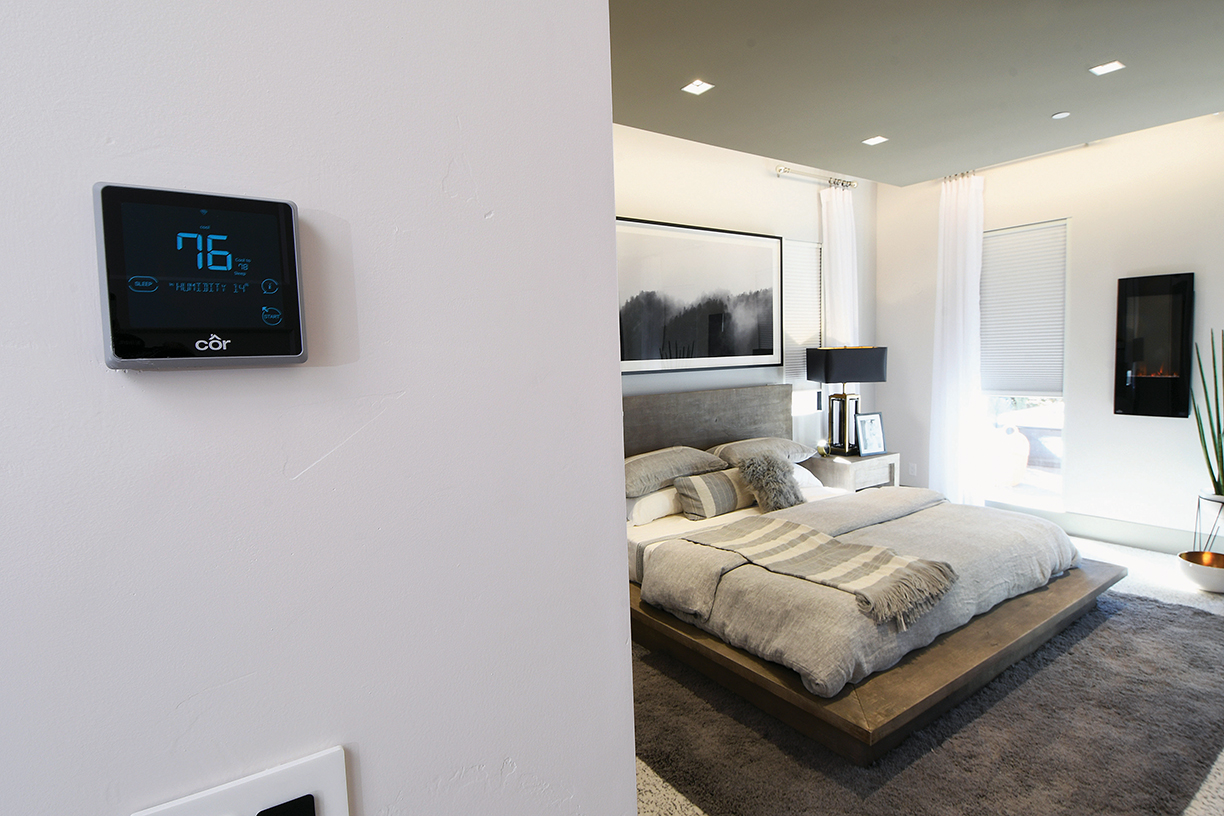
“It might mean one thing to one person and something else to another,” says designer Allie Mann with Case Architects and Remodelers in Washington, D.C., noting that some might be caught up in the movement without fully understanding it.
“I think that this is really being driven by a lot of consumer behavior. When it comes to the builder-developer world, I think our consumers are much more educated. I think they know what they want. They just don’t know how to get there,” says Angela Harris, creative director and principal of TRIO, an award-winning, market-driven, full-service interior design firm in Denver.
“Health and wellness is a new frontier for all of us, says Jacob Atalla, vice president of sustainability for KB Home. KB Home, along with Hanley Wood, KTGY Architects and Delos, a tech and wellness company, created a concept home outside of Las Vegas in Henderson, Nevada, to illustrate what a home designed with wellness as a core value looks like and how it functions. “It is the home story of the future,” he says.
Even though wellness seems to have suddenly burst onto the housing scene in the last year, the idea of connecting home to health is not new. More than 20 years ago, health issues potentially linked to building materials and toxic conditions such as black mold gained attention, giving rise to the term sick building syndrome. Since then, awareness of the relationship between the built environment and health has been growing. A decade ago, new technologies led to the development of products that either reduced the level of toxic contaminants released into the indoor ecosystem or scrubbed the air of VOCs (volatile organic compounds). Other concerns about noise, water and connections with the natural environment were also beginning to surface. At the same time, health and wellness was becoming an important value for consumers worldwide, expanding beyond fitness to include personalized medicine, mind-body connections, spa, wellness tourism and also the built environment.
By 2015, wellness had morphed into a $3.7 trillion industry worldwide, according to the Global Wellness Institute, and climbed an additional 6.4 percent annually to reach $4.2 trillion in 2017. One of the fastest growing sectors in the wellness space is a category called Wellness Lifestyle Real Estate, which includes everything in the built environment that incorporates wellness elements in design, construction, amenities and service. In addition to physical well-being, wellness real estate also addresses social wellness and mental, emotional and spiritual wellness.
The biggest difference between homes designed to promote wellness and homes that address air quality or other environmental factors that impact physical health is that wellness is integral to the design and permeates every aspect of the home from floor plan to amenities. “Overall you are programming the home to be more livable,” says Harris.
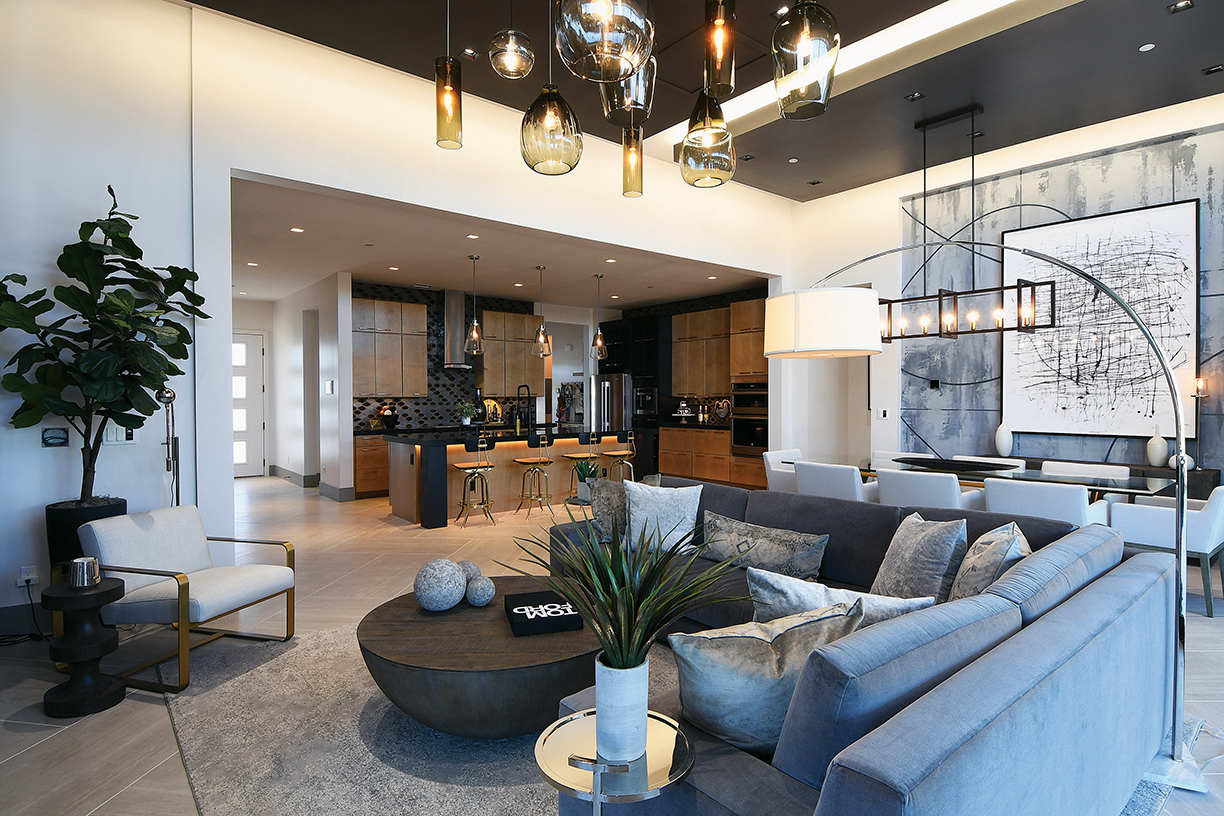
Frustrated by the lack of attention to the ways in which indoor environments influence health, Phil Scalia, a former partner at Goldman Sachs, founded the initiative that eventually became Delos, which has been on the forefront of wellness in the built environment for more than 10 years. In 2014, Delos established the WELL Building Standard, which was initially applied to commercial buildings. Over 1,200 projects in 45 countries, across over 250 million square feet of commercial real estate, fall under the WELL umbrella. The WELL standard focuses on seven categories of building performance: air, water, nourishment, light, fitness, comfort and mind. Additionally, it takes connections between a building and the surroundings into consideration.
During groundbreaking work on EcoManor, the first LEED Gold certified single-family residence in the U.S., designer Jillian Pritchard Cooke discovered that both consumers and design and construction professionals lacked accurate information on how to reduce toxins in the interior environment. That was the inspiration for Wellness Within Your Walls, another wellness certification that offers education on building and designing healthier interior environments. The focus is on materials both for construction and also furnishings and finishes.
Another more recent wellness initiative centers around the principles of biophilic design and the benefits of bringing natural elements into buildings. In 2016, Amanda Sturgeon, a biophilic design expert and CEO of the International Living Future Institute spearheaded the Biophilic Design Initiative. In addition to designers, builders and architects, current proponents include tech companies who have added natural elements to buildings to increase productivity and reduce stress for workers.
This year, it’s fair to say wellness is coming home as attention shifts from commercial to residential applications. The KB ProjeKt Home takes wellness in residential structures to the next level. Not only are established practices regarding connections with the outdoors, indoor toxins and air quality embedded in the design, but a synergy with smart home tech transforms wellness from a passive attribute into one that is active.
“The motivation was to examine how we can make the home healthier and at the same time how do we engage that home in partnering with the occupants, with the people living in it, to enhance their health and wellness or engage them in making the environment they live in better. We know that about 90 percent of our lives are spent indoors, and a lot of that indoor living is in your own home,” Atalla explains. Recent research from Hanley Wood shows that homeowners believe housing is essential or extremely important to good health, and two-thirds say the right housing environment could cut annual medical costs by 40 percent.
Central to the home’s wellness quotient is an innovative smart system, dubbed DARWIN, developed by Delos. This first of its kind, home wellness intelligence network constantly monitors the home environment and interacts with and adjusts systems in the home as needed. A network of sensors built into the walls — there are nine in the ProjeKt Home — constantly tests air quality.
If it detects problems with air quality, containments or chemicals from everyday products, DARWIN directs the climate control systems to bring more fresh air to that room. Water quality is also monitored, and purified water is delivered to every fixture in the home. “You have a wellness intelligence system that is constantly doing things on your behalf to increase your wellbeing,” says Atalla.
The system also monitors the plumbing system and alerts homeowners to leaks. Sleep is an important wellness component and the master bedroom in this home is primed to promote slumber. Special noise-damping drywall ensures quiet. Motorized shades block out exterior light. “Total quietness, total darkness, and circadian rhythms help you sleep,” adds Atalla.
Lighting is another mainstay of wellness formulas, both natural light from large windows and expanses of glass as well as interior lighting keyed to circadian rhythms. DARWIN adjusts lights to match the time of day. But what makes this function more worthwhile is the homeowner can change the lighting to produce a desired effect, which means the lights can create an energizing morning environment even if morning comes at 5 a.m. on a stormy day.

A living garden wall enables the home to grow herbs and microgreens. Turning the home and kitchen into a place to produce healthy food is an emerging area of innovation for kitchens.
Social interaction is another wellness component, and community design increasingly takes social interaction into account with spaces such as walking trails, parks and coffee houses designed to encourage interaction and encounters among residents as part of everyday life.
It might seem like a big jump to add wellness to typical new homes, particularly production homes, but Atalla says the KB ProjeKt Home is an example of what can be done. Additionally, Harris says it’s often an easy tweak to add features such as water filtration in the kitchen and master bath. “That doesn’t cost a whole lot. And again, I think it’s just about livability and how you’re programming your floor plan to be more livable.”
Looking ahead, most research points to continued growth of the wellness economy, with new initiatives approaching wellness from the perspective of design, construction, materials and function. There are now more than 740 wellness real estate and community developments built or in development across 34 countries — a number that grows weekly according to the Global Wellness Institute.
Right now, the $134 billion wellness real estate market is about half the size of the global green building industry and projections call for the pace to continue. “But the wellness market isn’t just growing, it’s extremely dynamic. We believe that the three sectors that represent the core spheres of life will see the strongest future growth — wellness real estate, workplace wellness and wellness tourism — while other sectors will also grow as they support the integration of wellness into all aspects of daily life,” says Ophelia Yeung, senior research fellow, GWI.


